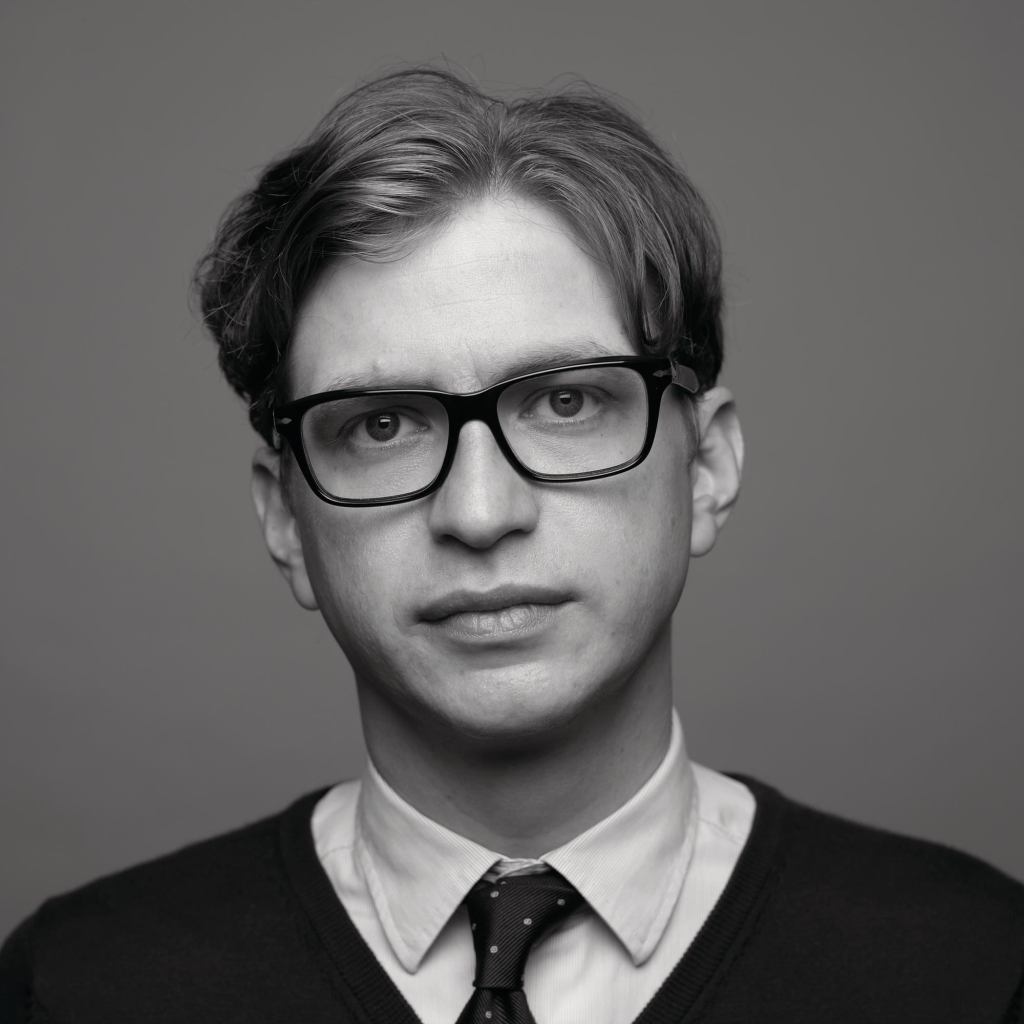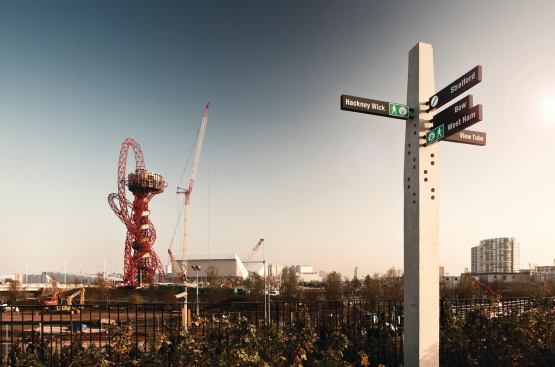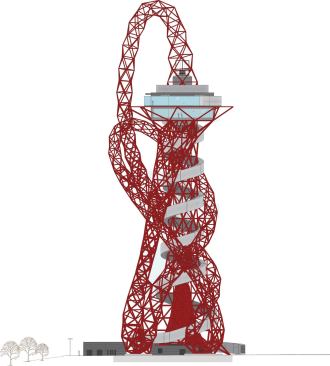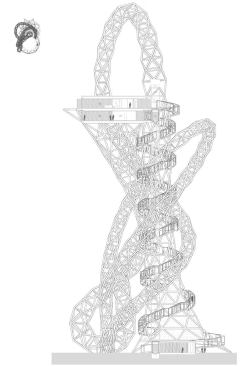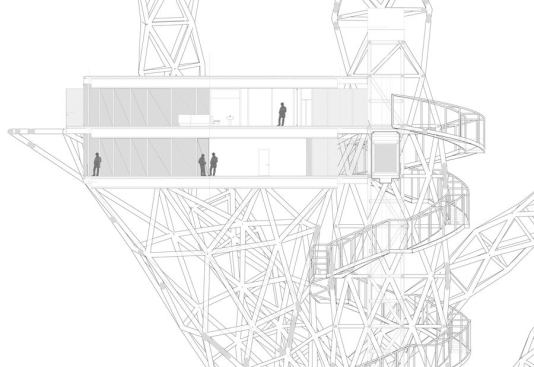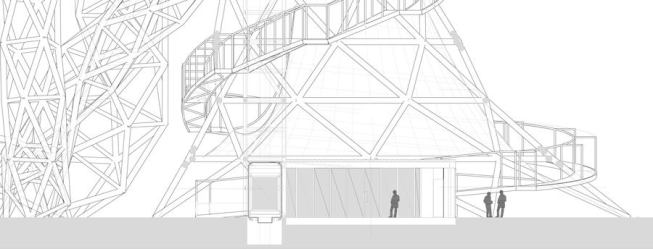Dylan Collard
The totem for the London Olympics, the ArcelorMittal Orbit tower…
The name of the ArcelorMittal Orbit tower is a real mouthful, a hybrid title for a mongrel artwork. The contorted steel “sculpture-cum-tower-cum-engineering feat,” in the inelegant phrase of Tate director Nicholas Serota, is the totem of our Olympic games, rising more than 375 feet out of the central plaza of the park, on former light industrial land equidistant between Stratford and Hackney Wick in east London.
Its $35.5 million price conveys significance, but no one is exactly sure what it is or what it means. It is an image, a placeholder, an attraction in a field of attractions. It is a signpost to an absence, a Hitchcockian MacGuffin. In short, it is what you build when you don’t know what the public realm is any more.
Working backwards through its ungainly name describes its genesis.
The “tower” part was dreamed up by London mayor Boris Johnson, who decided in 2008 that the city’s Olympic plans, conceived before his mayoralty, needed a little extra pizzazz: a sprig of parsley on a soup that, despite costing $14.5 billion, was being discusssed as an “austerity Olympics.” The majority of the sporting venues were to be temporary, and the permanent ones—the demountable, Meccano-like stadium; Zaha Hadid’s aquatics center with its disfiguring temporary “wings” of seating—were looking comparatively underwhelming after the excesses of Beijing.
The mayor writes in the promotional literature for the tower: “I thought we might have a kind of 21st century Trajan’s Column, with a winding frieze of modern Londoners, perhaps done by primary school children. That was soon left on the drawing board, eclipsed by the daring suggestions of some of the greatest artists in the world.” While our mayor modestly dreamed of emulating a Roman emperor, the art world had still bigger ideas.
The “Orbit” part of the moniker was the culture industry’s answer. It was invented by British sculptor Anish Kapoor and Arup engineer Cecil Balmond, the self-styled creative genius of structural engineering who runs Arup’s Advanced Geometry Unit. Kapoor and Balmond were announced as winners of a design competition in 2010, and still haven’t really cleared up for us what their motivations are. Kapoor has said that he wants the tower to have a sense of “instability” and continual movement. They also talk a lot about the Orbit as a kind of anti-tower, a nonlinear structure that is emphatically not what they call a “traditional, pyramidal” tower of building components stacked one on top of the other. There is something contorted about it, but the thing doesn’t look particularly unstable. The spiraling, silver, galvanized-steel staircase serves as its core, with twisting steel red ribbons as decoration.
In its references, Kapoor suggests that the building sits somewhere between the towers of Babel, Eiffel, and Tatlin. He describes visitors’ journeys up and down the tower (it has a double-decker viewing platform near the top, capable of holding 300 visitors) as a “procession.” But when Kapoor says that all this “has something mythic about it,” it is less obvious that he has any particular myth in mind. It’s an atmosphere he’s after, a generalization. The orbit is an overgrown maypole in a world that has replaced magic with spectacle. As for Balmond, he utters the commonplaces of the engineer: “We want people to forget the engineering, the construction, the materials and simply ‘experience’ it.” He could have said the same about a roller coaster.
But experience it they will, at least according to Mayor Johnson. For this is not just an artwork, it is intended to contribute to the regeneration of east London. “This is a very hard-headed venture, because we need to justify the huge sums of money that we are investing in east London,” he told the Australian Broadcasting Company. “And so we need to make sure people come to east London for generations to come.” The Orbit will be a paying visitor attraction in the post-games park. In that sense, this is an urban proposal, one that decorates east London in order to make it worthy of a visit by tourists. This is part of the “legacy” of the Olympics—the price east London must pay for the Olympic bounty bestowed on it.
The final part of a trinity that combines politics, art, and wealth is the “ArcelorMittal” part of the sculpture’s title. ArcelorMittal is a global steel company that employs less than 1 percent of its 263,000 employees in the UK, and is headquartered in the tax haven of Luxembourg. Its owner, Lakshmi Mittal, is the richest man in Britain; he last appeared in public life when he was embroiled in a cash-for-influence scandal during Tony Blair’s premiership. Johnson approached Mittal in a coat-check room at the World Economic Forum in Davos, Switzerland, in 2009, and got $30 million out of him in return for naming rights and, presumably, Mittal’s public rehabilitation as a grand patron of contemporary art.
What we know of Mittal’s architectural taste is best evidenced by the “Taj Mittal,” a London palace outfitted with marble from the same quarry that supplied the Taj Mahal. His Scottish holiday home is reportedly furnished by Ralph Lauren. It would be easy to ascribe similar gaucheness in this multi-billionaire paying to name a monument after himself. But the truth is that the corporate sponsorship of the project is key to its meaning. The name of this tower was sold off like a football stadium’s—and just as the Emirates replaced Highbury, and Etihad replaced the City of Manchester, so the ArcelorMittal Orbit tower sublimates geography into the placelessness of today’s corporations. (With all due respect to Luxembourg.)
The ArcelorMittal Orbit tower’s scale and nonspecific character means, though, that criticism just slides off it. The promotional literature—which reads like a bunch of rich men, including Johnson, Mittal, Kapoor, Balmond, and Serota, furiously backslapping each other—shows how a piece of public art this big and this political can more or less be all things to all people. It is a self-proclaimed regeneration tool, moneymaking visitor attraction, corporate logo, monument to sporting achievement, “icon,” piece of structural innovation, steel catalog, and monument that its authors hope will rival the Statue of Liberty, the Eiffel Tower, and so on. But what it really points to is that the thing we understand best about urbanism today is how to attract people to a place and how to take money off them on the way. Seventy percent of spectators at the London Olympics will pass through the massive new Westfield shopping mall on the way to see their sporting heroes perform. This relationship between Europe’s biggest urban mall and the Olympic Park is the real reason for the ArcelorMittal Orbit. Minister for the Olympics Tessa Jowell said, at the project’s unveiling, that it “will be like honey to bees for the millions of tourists that visit London each year.” Like an anchor tenant on the scale of the whole city, Kapoor’s twisting tower will see tourists sweep through, and east London will benefit from the coffee they buy on the way.
